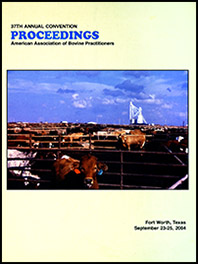Preliminary Study to Evaluate the Feasibility of Chemical Ablation of the Seminal Vesicles in the Bull
DOI:
https://doi.org/10.21423/aabppro20044978Keywords:
seminal vesiculitis, sperm motility, leukocyte contamination, breeding soundness, ethmoidal hematomas, formaldehyde solutionAbstract
Bulls affected with septic seminal vesiculitis are often classified as unsatisfactory potential breeders due to leukocyte contamination, poor sperm motility and other abnormalities noted during the breeding soundness examination.1,2 The prognosis of chronically affected bulls for resolution of this condition using antimicrobial therapy, sclerosing agents or surgical removal is guarded at best.1,2,5 Because of this poor response to present treatment options, we performed a preliminary study investigating a method of chemically ablating the entire seminal vesicle with a 4% formaldehyde solution. In horses, ablation of ethmoidal hematomas and salivary glands using a 4% formaldehyde solution is successfully documented.3,4 The goal of this study was to determine the feasibility of injecting the seminal vesicles of healthy bulls, percutaneously, with a 4% solution of formaldehyde, and the efficacy of this procedure in ablating the parenchyma of the seminal vesicles as a potential treatment of chronic septic seminal vesiculitis.


